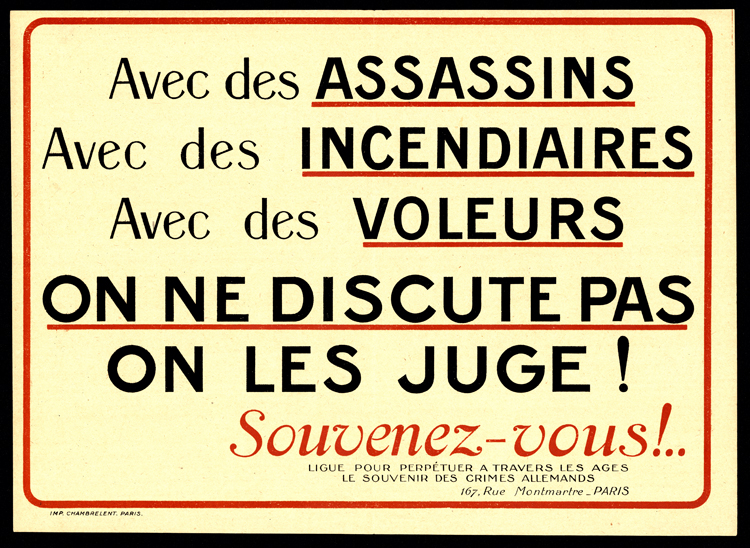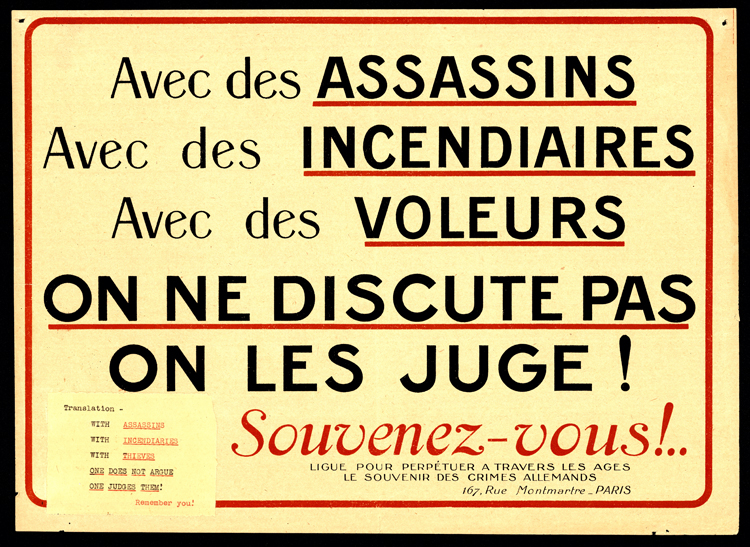Details
Collection: 10935 Digitized Images from Collection
Title: World War I (WWI) Posters
Date: 1914-1918
Summary: World War I era posters were gathered in 1917 and 1918 by Melvin R. Gilmore, State Historical Society curator from 1916 to 1923. The collection consists of 921 posters (individual images), including some from foreign countries. Gilmore actively worked to build as complete a collection as possible, obtaining duplicate American posters which he then exchanged with European dealers. The result is an extensive collection of poster art, or poster propaganda, at its zenith. Some of the posters Gilmore obtained were obviously used and show the marks resulting from hanging. Others, just as obviously, were never displayed.In the era before radio and television, perhaps the most striking communication device was the poster. An army of designers and illustrators volunteered to do figurative battle on walls and fences and in store windows. Charles Dana Gibson (creator of the Gibson Girl) led the "Division of Pictorial Publicity," formed the month the United States entered World War I, April 1917. Meeting weekly to farm out requests for posters from Government departments, the committee, through its art, recruited soldiers and sailors, raised money to finance the war effort, mobilized public opinion, and increased the production of industrial and agricultural goods. Blacks and dark greens out-lined the shadowy, evil countenances of the Kaiser and his minions while bright colors, most prominently reds, whites, and blues, clearly identified the forces of liberty. Every activity was a patriotic effort which, if completed successfully, would lead to victory. Clearly, food was ammunition in the battle fought by the United States Food Administration. Farmers were advised to grow more food, workers urged to build more ships, and all Americans asked to eat less meat and wheat. At times posters drew people to the young medium destined to be even more powerful, the motion picture. "See Your Boy March By," North Dakota's proud parents were told. The strong and unvarying emotional appeal to patriotism and duty runs throughout the collection of posters.Liberty Loan PostersWhile taxes were increased, most of the war funds were raised by the Treasury borrowing through a series of bond issues. The first four issues were called "Liberty Loans," while the fifth and last, issued after actual hostilities had ended, was called the "Victory Loan."Every possible means was employed to convince Americans to purchase bonds. Movie stars ? William S. Hart, Mary Pickford, Douglas Fairbanks, and Charlie Chaplin to name a few ? appeared in short films promoting the sale of bonds; "four-minute men" spoke in theaters, hotels, and restaurants; ministers made pleas from pulpits; mass meetings were held. And names of purchasers were published in newspaper "honor rolls."In this era before radio and television, the most striking communication device used to sell bonds was the poster. Many of the designs for the Liberty Loan posters can be attributed to the Division of Pictorial Publicity. None of the participants accepted fees for this work.The Liberty Loan campaigns were astonishingly successful. The Treasury Department borrowed $21,477,355,850 as a result of the five campaigns ? over $2.5 billion less than had been subscribed. The $21.4 billion represented over 66 million individual subscriptions. It was estimated that from one-fourth to one-third of the entire population of the United States possessed one or more Liberty Bonds or Victory Notes. Prior to this country's entry into the war, all outstanding bonds of the government amounted to less than $1.4 billion.Like most Americans, North Dakotans over-subscribed to the campaigns, pledging to buy over $66 million worth of bonds. The North Dakota campaigns for the First and Second Liberty Loans were headed by former governor (1913-1916) and director of the Minneapolis regional reserve bank Louis B. Hanna. The remaining drives were chaired by Wesley C. McDowell, Marion banker, farmer, and former state senator from LaMoure Cou
Collection: 10935 Digitized Images from Collection
Title: World War I (WWI) Posters
Date: 1914-1918
Summary: World War I era posters were gathered in 1917 and 1918 by Melvin R. Gilmore, State Historical Society curator from 1916 to 1923. The collection consists of 921 posters (individual images), including some from foreign countries. Gilmore actively worked to build as complete a collection as possible, obtaining duplicate American posters which he then exchanged with European dealers. The result is an extensive collection of poster art, or poster propaganda, at its zenith. Some of the posters Gilmore obtained were obviously used and show the marks resulting from hanging. Others, just as obviously, were never displayed.In the era before radio and television, perhaps the most striking communication device was the poster. An army of designers and illustrators volunteered to do figurative battle on walls and fences and in store windows. Charles Dana Gibson (creator of the Gibson Girl) led the "Division of Pictorial Publicity," formed the month the United States entered World War I, April 1917. Meeting weekly to farm out requests for posters from Government departments, the committee, through its art, recruited soldiers and sailors, raised money to finance the war effort, mobilized public opinion, and increased the production of industrial and agricultural goods. Blacks and dark greens out-lined the shadowy, evil countenances of the Kaiser and his minions while bright colors, most prominently reds, whites, and blues, clearly identified the forces of liberty. Every activity was a patriotic effort which, if completed successfully, would lead to victory. Clearly, food was ammunition in the battle fought by the United States Food Administration. Farmers were advised to grow more food, workers urged to build more ships, and all Americans asked to eat less meat and wheat. At times posters drew people to the young medium destined to be even more powerful, the motion picture. "See Your Boy March By," North Dakota's proud parents were told. The strong and unvarying emotional appeal to patriotism and duty runs throughout the collection of posters.Liberty Loan PostersWhile taxes were increased, most of the war funds were raised by the Treasury borrowing through a series of bond issues. The first four issues were called "Liberty Loans," while the fifth and last, issued after actual hostilities had ended, was called the "Victory Loan."Every possible means was employed to convince Americans to purchase bonds. Movie stars ? William S. Hart, Mary Pickford, Douglas Fairbanks, and Charlie Chaplin to name a few ? appeared in short films promoting the sale of bonds; "four-minute men" spoke in theaters, hotels, and restaurants; ministers made pleas from pulpits; mass meetings were held. And names of purchasers were published in newspaper "honor rolls."In this era before radio and television, the most striking communication device used to sell bonds was the poster. Many of the designs for the Liberty Loan posters can be attributed to the Division of Pictorial Publicity. None of the participants accepted fees for this work.The Liberty Loan campaigns were astonishingly successful. The Treasury Department borrowed $21,477,355,850 as a result of the five campaigns ? over $2.5 billion less than had been subscribed. The $21.4 billion represented over 66 million individual subscriptions. It was estimated that from one-fourth to one-third of the entire population of the United States possessed one or more Liberty Bonds or Victory Notes. Prior to this country's entry into the war, all outstanding bonds of the government amounted to less than $1.4 billion.Like most Americans, North Dakotans over-subscribed to the campaigns, pledging to buy over $66 million worth of bonds. The North Dakota campaigns for the First and Second Liberty Loans were headed by former governor (1913-1916) and director of the Minneapolis regional reserve bank Louis B. Hanna. The remaining drives were chaired by Wesley C. McDowell, Marion banker, farmer, and former state senator from LaMoure Cou
Enter a subject or term in one or both of the “Search” boxes.
- “Item Detail” searches the Title, Creator and Summary fields of all item-level records.
- “Collection Number” searches the Collection Number field only and requires an exact match.
The “DETAILS” button provides additional information about an item, as well as the following options:
- “Collection Summary” details the contents of the entire collection in which the selected item is located.
- You can print the image and its corresponding details by selecting “Print".
- “Digitized Images from the Collection” returns a list of all digitized items within that collection (available from the “Collection Summary” screen).
Click on image to expand/zoom the image view.
“Photobook home” takes you back to the main Photobook page where you can start a new search.
“Featured Collections” showcases new and/or popular collections and the digitized images within those collections.
Information on how to order copies is located here.
The collections preserved in the North Dakota State Archives include over a million images. Only a small percentage of these images have been digitized. This photo gallery provides a preview of the images that have been digitized.
For more information on the non-digitized images, please refer to the finding aids found on our website at history.nd.gov, or ask a member of our reference staff for assistance.



